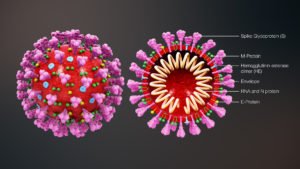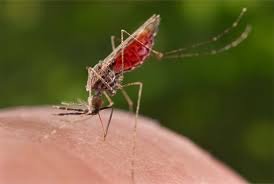The Ebola virus causes an acute, serious illness which is often fatal if untreated. EVD first appeared in 1976 in 2 simultaneous outbreaks, one in what is now Nzara, South Sudan, and the other in Yambuku, DRC. The latter occurred in a village near the Ebola River, from which the disease takes its name.
The 2014–2016 outbreak in West Africa was the largest Ebola outbreak since the virus was first discovered in 1976. The outbreak started in Guinea and then moved across land borders to Sierra Leone and Liberia. The current 2018-2019 outbreak in eastern DRC is highly complex, with insecurity adversely affecting public health response activities.
The virus family Filoviridae includes three genera: Cuevavirus, Marburgvirus, and Ebolavirus. Within the genus Ebolavirus, six species have been identified: Zaire, Bundibugyo, Sudan, Taï Forest, Reston and Bombali. The virus causing the current outbreak in DRC and the 2014–2016 West African outbreak belongs to the Zaire ebolavirus species.
Transmission
It is thought that fruit bats of the Pteropodidae family are natural Ebola virus hosts. Ebola is introduced into the human population through close contact with the blood, secretions, organs or other bodily fluids of infected animals such as fruit bats, chimpanzees, gorillas, monkeys, forest antelope or porcupines found ill or dead or in the rainforest.
Ebola then spreads through human-to-human transmission via direct contact (through broken skin or mucous membranes) with:
- Blood or body fluids of a person who is sick with or has died from Ebola
- Objects that have been contaminated with body fluids (like blood, feces, vomit) from a person sick with Ebola or the body of a person who died from Ebola
Health-care workers have frequently been infected while treating patients with suspected or confirmed EVD. This occurs through close contact with patients when infection control precautions are not strictly practiced.
Burial ceremonies that involve direct contact with the body of the deceased can also contribute in the transmission of Ebola.
People remain infectious as long as their blood contains the virus.
Pregnant women who get acute Ebola and recover from the disease may still carry the virus in breastmilk, or in pregnancy related fluids and tissues. This poses a risk of transmission to the baby they carry, and to others. Women who become pregnant after surviving Ebola disease are not at risk of carrying the virus.
If a breastfeeding woman who is recovering from Ebola wishes to continue breastfeeding, she should be supported to do so. Her breast milk needs to be tested for Ebola before she can start. For more, read the guidelines on the management of pregnancy and breastfeeding in Ebola.
Symptoms
The incubation period, that is, the time interval from infection with the virus to onset of symptoms, is from 2 to 21 days. A person infected with Ebola cannot spread the disease until they develop symptoms.
Symptoms of EVD can be sudden and include:
- Fever
- Fatigue
- Muscle pain
- Headache
- Sore throat
This is followed by:
- Vomiting
- Diarrhoea
- Rash
- Symptoms of impaired kidney and liver function
- In some cases, both internal and external bleeding (for example, oozing from the gums, or blood in the stools).
- Laboratory findings include low white blood cell and platelet counts and elevated liver enzymes.
Diagnosis
It can be difficult to clinically distinguish EVD from other infectious diseases such as malaria, typhoid fever and meningitis. Many symptoms of pregnancy and Ebola disease are also quite similar. Because of risks to the pregnancy, pregnant women should ideally be tested rapidly if Ebola is suspected.
Confirmation that symptoms are caused by Ebola virus infection are made using the following diagnostic methods:
- antibody-capture enzyme-linked immunosorbent assay (ELISA)
- antigen-capture detection tests
- serum neutralization test
- reverse transcriptase polymerase chain reaction (RT-PCR) assay
- electron microscopy
- ·virus isolation by cell culture.
Careful consideration should be given to the selection of diagnostic tests, which take into account technical specifications, disease incidence and prevalence, and social and medical implications of test results. It is strongly recommended that diagnostic tests, which have undergone an independent and international evaluation, be considered for use.
Current WHO recommended tests include:
- Automated or semi-automated nucleic acid tests (NAT) for routine diagnostic management.
- Rapid antigen detection tests for use in remote settings where NATs are not readily available. These tests are recommended for screening purposes as part of surveillance activities, however reactive tests should be confirmed with NATs.
The preferred specimens for diagnosis include:
- Whole blood collected in ethylenediaminetetraacetic acid (EDTA) from live patients exhibiting symptoms.
- Oral fluid specimen stored in universal transport medium collected from deceased patients or when blood collection is not possible.
Samples collected from patients are an extreme biohazard risk; laboratory testing on non-inactivated samples should be conducted under maximum biological containment conditions. All biological specimens should be packaged using the triple packaging system when transported nationally and internationally.
Treatment
Supportive care – rehydration with oral or intravenous fluids – and treatment of specific symptoms improves survival. There is as yet no proven treatment available for EVD. However, a range of potential treatments including blood products, immune therapies and drug therapies are currently being evaluated.
In the ongoing 2018-2019 Ebola outbreak in DRC, the first-ever multi-drug randomized control trial is being conducted to evaluate the effectiveness and safety of drugs used in the treatment of Ebola patients under an ethical framework developed in consultation with experts in the field and the DRC.
Pregnant and breastfeeding women with Ebola should be offered early supportive care, like general population. Likewise experimental treatment should be offered under the same conditions as for non-pregnant population.
Vaccines
An experimental Ebola vaccine proved highly protective against EVD in a major trial in Guinea in 2015. The vaccine, called rVSV-ZEBOV, was studied in a trial involving 11 841 people. Among the 5837 people who received the vaccine, no Ebola cases were recorded 10 days or more after vaccination. In comparison, there were 23 cases 10 days or more after vaccination among those who did not receive the vaccine.
The rVSV-ZEBOV vaccine is being used in the ongoing 2018-2019 Ebola outbreak in DRC. Pregnant and breastfeeding women should have access to the vaccine under the same conditions as for the general population.
Initial data indicates that the vaccine is highly effective.
WHO’s Strategic Advisory Group of Experts has stated the need to assess additional Ebola vaccines.
Prevention and control
Good outbreak control relies on applying a package of interventions, including case management, surveillance and contact tracing, a good laboratory service, safe burials and social mobilisation. Community engagement is key to successfully controlling outbreaks. Raising awareness of risk factors for Ebola infection and protective measures (including vaccination) that individuals can take is an effective way to reduce human transmission. Risk reduction messaging should focus on several factors:
- Reducing the risk of wildlife-to-human transmission from contact with infected fruit bats, monkeys, apes, forest antelope or porcupines and the consumption of their raw meat. Animals should be handled with gloves and other appropriate protective clothing. Animal products (blood and meat) should be thoroughly cooked before consumption.
- Reducing the risk of human-to-human transmission from direct or close contact with people with Ebola symptoms, particularly with their bodily fluids. Gloves and appropriate personal protective equipment should be worn when taking care of ill patients. Regular hand washing is required after visiting patients in hospital, as well as after taking care of patients at home.
- Outbreak containment measures, including safe and dignified burial of the dead, identifying people who may have been in contact with someone infected with Ebola and monitoring their health for 21 days, the importance of separating the healthy from the sick to prevent further spread, and the importance of good hygiene and maintaining a clean environment.
- Reducing the risk of possible sexual transmission, based on further analysis of ongoing research and consideration by the WHO Advisory Group on the Ebola Virus Disease Response, WHO recommends that male survivors of EVD practice safer sex and hygiene for 12 months from onset of symptoms or until their semen tests negative twice for Ebola virus. Contact with body fluids should be avoided and washing with soap and water is recommended. WHO does not recommend isolation of male or female convalescent patients whose blood has been tested negative for Ebola virus.
- Reducing the risk of transmission from pregnancy related fluids and tissue, Pregnant women who have survived Eboa disease need community support to enable them to attend frequent antenatal care (ANC) visits, to handle any pregnancy complications and meet their need for sexual and reproductive care and delivery in a safe way. This should be planned together with the Ebola and Obstetric health care expertise. Pregnant women should always be respected in the sexual and reproductive health choices they make.
Controlling infection in health-care settings
Health-care workers should always take standard precautions when caring for patients, regardless of their presumed diagnosis. These include basic hand hygiene, respiratory hygiene, use of personal protective equipment (to block splashes or other contact with infected materials), safe injection practices and safe burial practices.
Health-care workers caring for patients with suspected or confirmed Ebola virus should apply extra infection control measures to prevent contact with the patient’s blood and body fluids and contaminated surfaces or materials such as clothing and bedding. When in close contact (within 1 metre) of patients with EVD, health-care workers should wear face protection (a face shield or a medical mask and goggles), a clean, non-sterile long-sleeved gown, and gloves (sterile gloves for some procedures).
Laboratory workers are also at risk. Samples taken from humans and animals for investigation of Ebola infection should be handled by trained staff and processed in suitably equipped laboratories.
![]()




